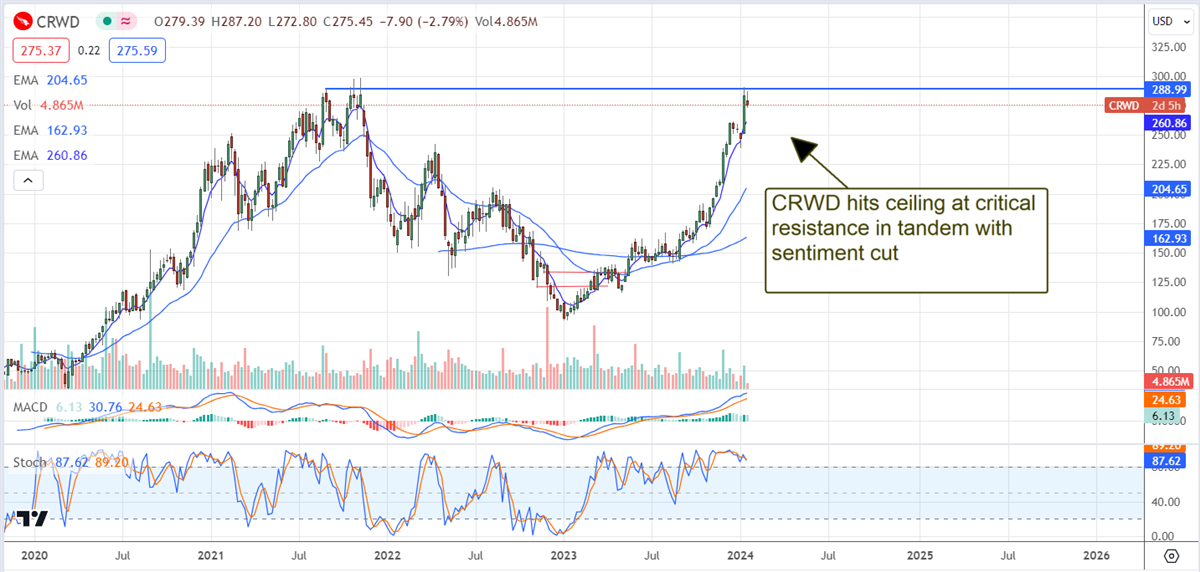Amid recent shifts in the market, financial analysts have downgraded two prominent cybersecurity stocks, a development that has sent shockwaves rippling through the entire industry. The downward pressure has pushed the likes of Cloudflare (NYSE:) and Palo Alto Networks (NASDAQ:) to experience a 2.5% to over a 4% decline, despite no noticeable change in their business outlook.
With business spending focused on digital transformation, the exponential growth of data centers, and the escalating threat of cyber attacks, the fundamentals underpinning the cybersecurity sector remain firmly intact. While this would typically suggest a buy-the-dip opportunity, the situation is clouded by the exorbitant valuations of many cybersecurity stocks. This troublesome reality has led many to believe that a peak has been reached for these stocks. The pertinent query then becomes how far these stocks will plummet and when they will start to rebound. Given the current state of the market, a significant decline may be imminent, and recovery could be a long and treacherous road.
The Rise and Risk of Crowdstrike Holdings Inc.
CrowdStrike Holdings (NASDAQ:) has significantly outpaced its peers in terms of share price growth and valuation. It has witnessed a nearly 200% surge in the past 12 months and is trading at an astounding 100x its earnings, a figure that dwarfs the 40x ratio of cybersecurity giant Palo Alto Networks, a company that is still achieving double-digit growth. While CrowdStrike is expected to maintain robust double-digit growth in the coming years, the pace of this expansion is projected to decelerate, ultimately converging at around 30% for the year. This would naturally scale down the valuation of the stock. However, this correction may not come swiftly enough to halt the market’s bullish sentiment.
Following a downgrade from “buy” to “hold” by Westpark, the market experienced a 4% retreat, as investors rushed to secure their gains. Westpark’s apprehensions are tied to the valuation in relation to near-term revenue and earnings projections, despite their optimism about the company’s ability to continue performing well. While Westpark refrained from specifying a price target, CRWD shares are currently trading a substantial 15% above the consensus, indicative of ongoing downward pressure on the stock until a fresh driver emerges. The upcoming Q4 results set to be unveiled in early March could potentially serve as a catalyst. Nonetheless, with analysts recently revising their estimates upwards, the bar may have been set unattainably high, casting doubt on whether the results will be potent enough to propel the stock to new heights.
Navigating Zscaler Inc.’s Future Amid Growth Deceleration
Zscaler (NASDAQ:) is yet another cybersecurity stock expected to sustain robust growth and earnings that have outstripped its justifiable valuation. With the stock currently trading at almost 100 times its earnings, the same as CrowdStrike, and the prospect of decelerating growth from the high 40% range in 2023 to the 30% range in 2024, followed by an anticipated 20% growth next year, the stock’s current valuation may be somewhat unwarranted, prompting KeyBanc to initiate a Sector Weight rating, noting that the stock is “simply too expensive.”
KeyBanc acknowledges Zscaler as a leader in the zero-trust SASE security space, which is expected to expand by 27% by 2028. However, the presence of larger-scale players such as Palo Alto Networks, Cisco (NASDAQ:), and even Microsoft (NASDAQ:) poses a considerable challenge to Zscaler’s efforts to grow its market share. Additionally, KeyBanc believes that the management’s prioritization of top-line growth over profits is creating a headwind for the stock’s valuation.
Although Zscaler holds a “moderate-buy” rating among analysts, with a potential 30% upside at the higher end of the target range, the stock is currently trading about 8% above the consensus figure, which has remained relatively steady over the past year. This suggests that the stock may retrace to that level, roughly around $206, before embarking on an upward trajectory. If the support at $206 wanes, there is a risk of a notably steeper decline. A 40% reduction in price would align the stock with the market leader, Palo Alto Networks, but would also bring it to the lower end of its trading range, an outcome that is unexpected.
While the aforementioned outlook may carry risks, given the historical tendency of both Zscaler and CrowdStrike to exceed expectations in terms of revenue and earnings, supported by ongoing secular trends and robust double-digit growth forecasts, a plausible scenario could see analysts revising their estimates upwards, thereby aligning the valuation more suitably. In this event, the price action in Zscaler may dip below $206 but find support well above the lower threshold of the trading range. The most promising targets for recovery would likely be around the 30-day EMA near $218. However, a bounce back to the middle of the trading range, situated near $192 just below the consensus target, appears to be a more realistic outcome.

